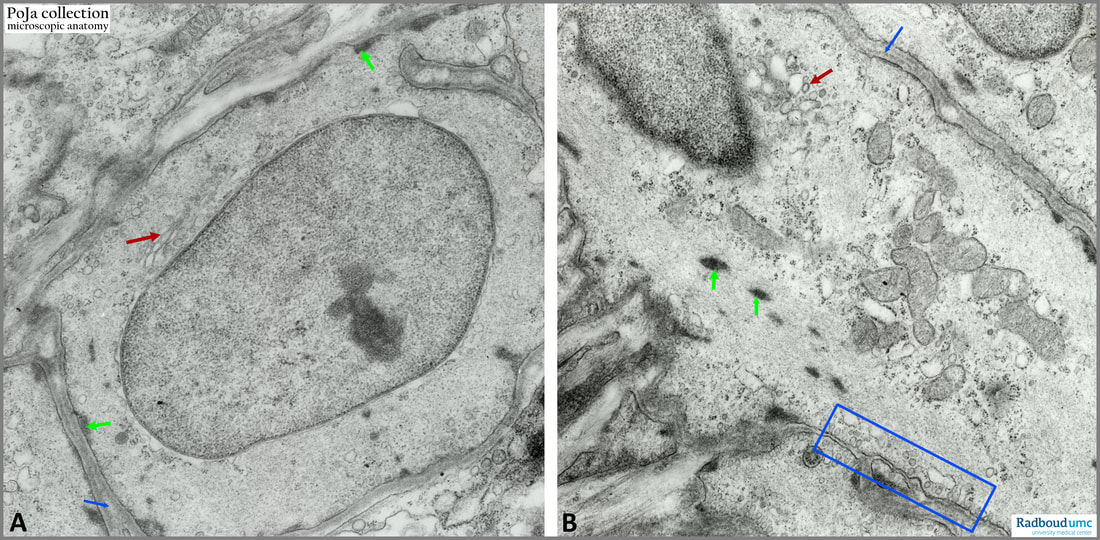14.3 POJA-L6010+6005 Electron micrograph of rabbit smooth muscle myocytes
14.3 POJA-L6010+6005 Electron micrograph of rabbit smooth muscle myocytes
Title: Electron micrograph of rabbit smooth muscle myocytes
Description:
(A): Cross section and (B): longitudinal section. Green arrows indicate the dense plaques as adherence sites (attachment plaques) for myofilaments. Red arrows point to vesicles as part of the Golgi regions. Blue arrow points to the “double” basal laminas of two adjacent cells. The blue rectangle highlights the caveolae near the cell membrane and to the (S)ER (endoplasmic reticulum).
The cell membrane (or sarcolemma) of the myocytes presents many caveolae or so-called pinocytotic vesicles and together with some sparse profile of endoplasmic reticulum (SER) they function analogous to the triad system in skeletal muscle to deliver calcium to the cytoplasm.
Background:
Cytoplasmic densities as well as plasma membrane densities (attachment plaques) are intracellular analogues of the Z-lines in skeletal muscle myofibres. These densities contain a-actinin as actin-binding proteins. An increase in the Ca2+ level concentration within the cytosol is necessary to initiate smooth muscle contraction. This increase is achieved either by initial depolarisation of the cell membrane or hormonal stimulation of cell surface receptors. By depolarisation of the sarcolemma the intracellular Ca2+ increases with subsequently activation of voltage-sensitive Ca2+ channels by directly activation of gated Ca2+-release channels (modified ryanodine receptors) in the SER. Calcium binding to calmodulin activates phosphorylation of the myosin light chain kinase. After phosphorylation myosin changes from inactive (folded) to active (folded) conformation. The actin-binding on the myosin head is activated and attach to actin filaments. In the presence of ATP, the myosin head bends producing contraction that shortens the cell and produces the corkscrew shape of the nucleus, well demonstrated in light microscopy. Phosphatases dephosphorylate myosin molecules resulting in disassembly of myosin filaments and relaxation. (Adapted from Ross and Pawlina in Histology A Text and Atlas 2016)
See also:
Keywords/Mesh: locomotor system, smooth muscle, dense plaque, electron microscopy, histology, POJA collection
Description:
(A): Cross section and (B): longitudinal section. Green arrows indicate the dense plaques as adherence sites (attachment plaques) for myofilaments. Red arrows point to vesicles as part of the Golgi regions. Blue arrow points to the “double” basal laminas of two adjacent cells. The blue rectangle highlights the caveolae near the cell membrane and to the (S)ER (endoplasmic reticulum).
The cell membrane (or sarcolemma) of the myocytes presents many caveolae or so-called pinocytotic vesicles and together with some sparse profile of endoplasmic reticulum (SER) they function analogous to the triad system in skeletal muscle to deliver calcium to the cytoplasm.
Background:
Cytoplasmic densities as well as plasma membrane densities (attachment plaques) are intracellular analogues of the Z-lines in skeletal muscle myofibres. These densities contain a-actinin as actin-binding proteins. An increase in the Ca2+ level concentration within the cytosol is necessary to initiate smooth muscle contraction. This increase is achieved either by initial depolarisation of the cell membrane or hormonal stimulation of cell surface receptors. By depolarisation of the sarcolemma the intracellular Ca2+ increases with subsequently activation of voltage-sensitive Ca2+ channels by directly activation of gated Ca2+-release channels (modified ryanodine receptors) in the SER. Calcium binding to calmodulin activates phosphorylation of the myosin light chain kinase. After phosphorylation myosin changes from inactive (folded) to active (folded) conformation. The actin-binding on the myosin head is activated and attach to actin filaments. In the presence of ATP, the myosin head bends producing contraction that shortens the cell and produces the corkscrew shape of the nucleus, well demonstrated in light microscopy. Phosphatases dephosphorylate myosin molecules resulting in disassembly of myosin filaments and relaxation. (Adapted from Ross and Pawlina in Histology A Text and Atlas 2016)
See also:
- 14.1 POJA-L6011+6033 Electron micrograph of rat smooth muscle cell
Keywords/Mesh: locomotor system, smooth muscle, dense plaque, electron microscopy, histology, POJA collection

